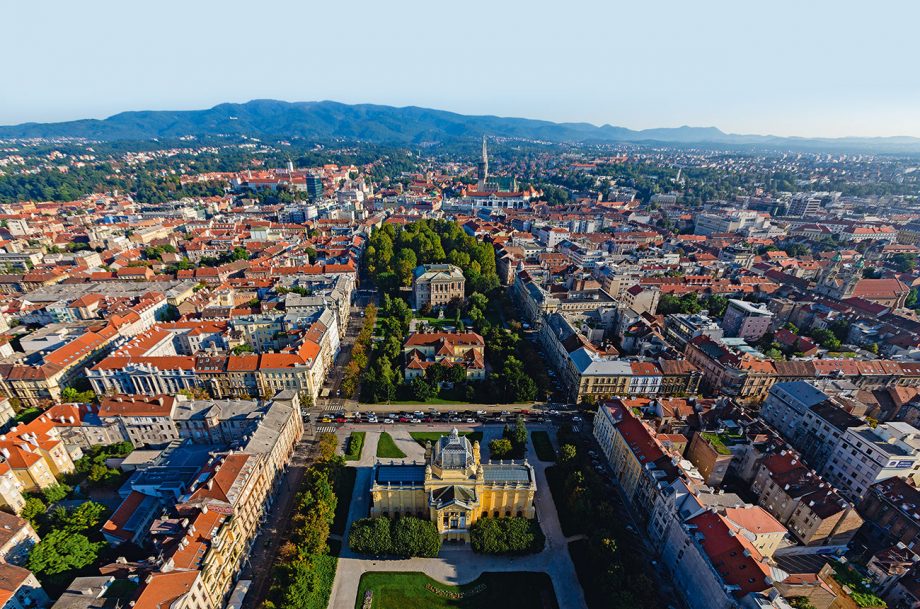In partnership with Vinart.
Exploring the Croatian Uplands
While the coast beckons summer tourists, Zagreb is Croatia’s most visited winter destination. The city is renowned for its markets and winter skiing, but the capital of Croatia is not just for Christmas.
With a compelling disregard for uniformity, Zagreb has a colourful chaos or architecture, ideal to explore by foot. Austro-Hungarian palaces, medieval cottages, bell-bottomed church spires, and brutalist housing blocks all populate different corners of the city, and Zagreb claims to have more museums per square metre than any other city. There’s even a museum dedicated to heartache.
Zagreb’s intellectual nourishment is overflowing but, as a thirsty traveller, I’m using the capital as a gateway to discover the wine lands of continental Croatia.
Just 20 minutes from the city vineyards emerge, folded into the foothills of the Croatian Uplands. Field blends grown in nests of wooden stakes mark the oldest vines, although these native varieties aren’t why Plešivica is known as ‘Croatia’s Champagne’. Instead, it’s the cool-climate Chardonnay, Pinot Noir and Riesling vines grown on the limestone-rich hillsides.
‘We’ve only been exploring our potential for traditional-method sparkling wine in the past decade,’ explains fifth-generation producer Velimir Korak, whose sons now run the winery and its restaurant. While a decade is only the blink of an eye for a region that’s been making wine since the Middle Ages, Plešivica is already considered the grand cru of Balkan bubbles. But producers are experimenting beyond the classics with red – and even orange – sparkling wine.
An amphora-aged bubbly doesn’t come as much of a surprise when you meet the innovative face behind it – Tomica Tomac – who, along with Zdenko Šember is one of Croatia’s leading qvevri producers. Made in traditional clay pots, these structured and yet refreshing wines sit wonderfully with the local speciality, black pig. The thick forests of the Croatian Uplands are a hotspot for game, as well as hiking and skiing.
Although it’s mid-springtime when I visit, the apres-ski mood is in full swing at Petrač winery. It’s here, as lunch rolls into dinner, that I learn my first Croatian colloquialism: putna. This term loosely translates as ‘one for the road’, but in reality it equates to imbibing for hours more. As a platter of roast duck and another bottle appear, I heartily agree to my first putna.

Credit: Filip Kelava
Tucking into Slavonia
Deeper into continental Croatian wine country, and further off the main tourist beat, lies Slavonia, where villages are quaint, folklore is rich and life is simple. The slopes of Slavonia are prime territory for Croatia’s most planted variety, Graševina, and its heartland is in Kutjevo. There’s a plethora of cellar doors to knock on: ranging from ultra-modern Galić to the oldest – and largest – cellar in town, Kutjevo, founded by Cistercian monks in 1232. The historic cellar offers an excellent opportunity to taste old vintages, from around €50.
As night falls, I head to another cellar – and my bed for the night – Sontacchi, run by brothers Kruno and Anton. ‘Slavonia is hipster now,’ says Kruno sardonically, while serving a barrel sample of his 2018 Superslav, a delicious skin-contact blend of native varieties.
I ask what the trademarks are of being Slav. ‘Well, making your own meat for a start,’ he replies, as Anton comes in with yet another plate of homemade charcuterie. Famed for its hospitality, your glass is never dry in Slavonia and local tradition is rubbing off on me now. ‘Putna?’ I volunteer, and Kruno doesn’t hesitate in taking samples from another Slavonian oak barrel.

Old cellar in Iločki Podrumi, Ilok, Croatian Danube
Delights of the Danube
In the upper corner of Slavonia lies the Croatian Danube, where picturesque villages overlook the river and Serbian border. The jewel in its crown is the medieval fortress town of Ilok, where more than a dozen wineries take advantage of the river’s microclimate.
The largest is Iločki Podrumi, its 15th-century cellar offering another engaging opportunity to taste library vintages, including the local speciality of Traminac.
Another local delicacy is paprika fish stew, which I enjoy at the river-beach bar and terrace restaurant of Hotel Dunav. Sitting by the riverside with a glass of wine, my host shares his last Croatian word of wisdom: jaka – the art of doing nothing.
Where to sleep and eat in the Croatian Uplands, Slavonia and Danube
Sleep
Zagreb is a great base from which to explore the Croatian Uplands, only half an hour’s drive from the city centre. For options in Slavonia’s wine hub of Kutjevo, try the homely apartments at Sontacchi, which is also home to Kutjevo’s liveliest bar, or book in at the Graševina Academy. One of the best views in the Danube wine region of Ilok is from the aparthotel and restaurant of Iločki Podrumi.
Eat
Lunch is best enjoyed at one of the many local wineries: try the brand- new restaurant at Korak (+385 1 6293 088) with a panoramic view over the Croatian Uplands; the contemporary tasting menu of Galić in Kutjevo; or the relaxed riverside restaurant of Hotel Dunav in the Danube region.
Getting there
British Airways flies direct from London Heathrow to Zagreb airport, which is 16km from Zagreb centre. Ilok is a 3.5hr drive from Zagreb.
Amanda Barnes is a wine and travel writer who has been based in South America since 2009





